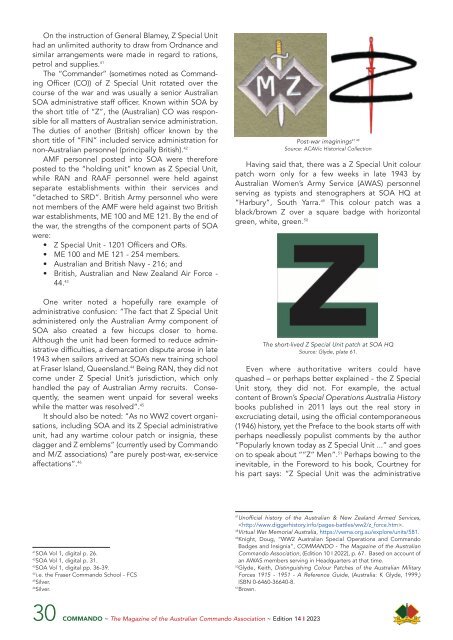Official Commando News Magazine edition 14 Mar 2023
You also want an ePaper? Increase the reach of your titles
YUMPU automatically turns print PDFs into web optimized ePapers that Google loves.
On the instruction of General Blamey, Z Special Unit<br />
had an unlimited authority to draw from Ordnance and<br />
similar arrangements were made in regard to rations,<br />
petrol and supplies. 41<br />
The “Commander” (sometimes noted as Com mand -<br />
ing Officer (CO)) of Z Special Unit rotated over the<br />
course of the war and was usually a senior Australian<br />
SOA administrative staff officer. Known within SOA by<br />
the short title of “Z”, the (Australian) CO was res pon -<br />
sible for all matters of Australian service administration.<br />
The duties of another (British) officer known by the<br />
short title of “FIN” included service administration for<br />
Post-war imaginings<br />
non-Australian personnel (principally British). 42<br />
AMF personnel posted into SOA were therefore<br />
posted to the “holding unit” known as Z Special Unit,<br />
while RAN and RAAF personnel were held against<br />
separate establishments within their services and<br />
“detached to SRD”. British Army personnel who were<br />
“Harbury”, South Yarra.<br />
not members of the AMF were held against two British<br />
49<br />
war establishments, ME 100 and ME 121. By the end of<br />
the war, the strengths of the component parts of SOA<br />
were:<br />
• Z Special Unit - 1201 Officers and ORs.<br />
• ME 100 and ME 121 - 254 members.<br />
• Australian and British Navy - 216; and<br />
• British, Australian and New Zealand Air Force -<br />
44. 43<br />
One writer noted a hopefully rare example of<br />
administrative confusion: “The fact that Z Special Unit<br />
administered only the Australian Army component of<br />
SOA also created a few hiccups closer to home.<br />
Although the unit had been formed to reduce admin -<br />
istrative difficulties, a demarcation dispute arose in late<br />
1943 when sailors arrived at SOA’s new training school<br />
at Fraser Island, Queensland. 44 Being RAN, they did not<br />
come under Z Special Unit’s jurisdiction, which only<br />
handled the pay of Australian Army recruits. Con se -<br />
quently, the seamen went unpaid for several weeks<br />
while the matter was resolved”. 45<br />
It should also be noted: “As no WW2 covert organi -<br />
sations, including SOA and its Z Special administrative<br />
unit, had any wartime colour patch or insignia, these<br />
dagger and Z emblems” (currently used by <strong>Commando</strong><br />
and M/Z associations) “are purely post-war, ex-service<br />
affectations”. 46<br />
47 48<br />
Source: ACAVic Historical Collection<br />
Having said that, there was a Z Special Unit colour<br />
patch worn only for a few weeks in late 1943 by<br />
Australian Women’s Army Service (AWAS) personnel<br />
serving as typists and stenographers at SOA HQ at<br />
This colour patch was a<br />
black/brown Z over a square badge with horizontal<br />
green, white, green. 50<br />
The short-lived Z Special Unit patch at SOA HQ<br />
Source: Glyde, plate 61.<br />
Even where authoritative writers could have<br />
quashed – or perhaps better explained - the Z Special<br />
Unit story, they did not. For example, the actual<br />
content of Brown’s Special Operations Australia History<br />
books published in 2011 lays out the real story in<br />
excruciating detail, using the official contemporaneous<br />
(1946) history, yet the Preface to the book starts off with<br />
perhaps needlessly populist comments by the author<br />
“Popularly known today as Z Special Unit ...” and goes<br />
on to speak about “”Z” Men”. 51 Perhaps bowing to the<br />
inevitable, in the Foreword to his book, Courtney for<br />
his part says: “Z Special Unit was the administrative<br />
47<br />
Unofficial history of the Australian & New Zealand Armed Services,<br />
.<br />
48<br />
Virtual War Memorial Australia, https://vwma.org.au/explore/units/581.<br />
41<br />
SOA Vol 1, digital p. 26.<br />
42<br />
SOA Vol 1, digital p. 31.<br />
43<br />
SOA Vol 1, digital pp. 36-39.<br />
44<br />
i.e. the Fraser <strong>Commando</strong> School - FCS<br />
45<br />
Silver.<br />
46<br />
Silver.<br />
49<br />
Knight, Doug, “WW2 Australian Special Operations and <strong>Commando</strong><br />
Badges and Insignia”, COMMANDO - The <strong>Magazine</strong> of the Australian<br />
<strong>Commando</strong> Association, (Edition 10 I 2022), p. 67. Based on account of<br />
an AWAS members serving in Headquarters at that time.<br />
50<br />
Glyde, Keith, Distinguishing Colour Patches of the Australian Military<br />
Forces 1915 - 1951 - A Reference Guide, (Australia: K Glyde, 1999,)<br />
ISBN 0-6460-36640-8.<br />
51<br />
Brown.<br />
30 COMMANDO ~ The <strong>Magazine</strong> of the Australian <strong>Commando</strong> Association ~ Edition <strong>14</strong> I <strong>2023</strong>
















